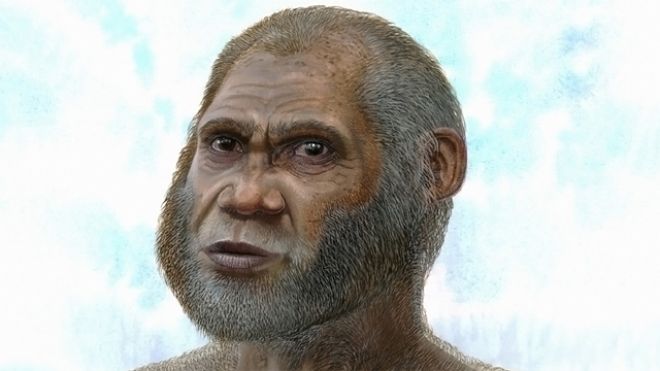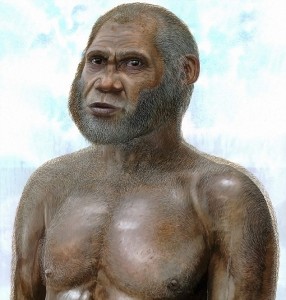
March 14, 2012
We were not alone. We are not alone. The world is revealing more of its fossil treasures – or at least humans looking through their storage areas of past finds are – and so here is some more breaking news of a find of a possibly new species of a relatively recent hominid.


A skull, possibly from a new species of human, recovered from Longlin cave in Guangxi province, China. Photograph: Darren Curnoe
The fossilised remains of stone age people recovered from two caves in south west China may belong to a new species of human that survived until around the dawn of agriculture.
The partial skulls and other bone fragments, which are from at least four individuals and are between 14,300 and 11,500 years old, have an extraordinary mix of primitive and modern anatomical features that stunned the researchers who found them.
Named the Red Deer Cave people, after their apparent penchant for home-cooked venison, they are the most recent human remains found anywhere in the world that do not closely resemble modern humans.
The individuals differ from modern humans in their jutting jaws, large molar teeth, prominent brows, thick skulls, flat faces and broad noses. Their brains were of average size by ice age standards.
“They could be a new evolutionary line or a previously unknown modern human population that arrived early from Africa and failed to contribute genetically to living east Asians,” said Darren Curnoe, who led the research team at the University of New South Wales in Australia.
“While finely balanced, I think the evidence is slightly weighted towards the Red Deer Cave people representing a new evolutionary line. First, their skulls are anatomically unique. They look very different to all modern humans, whether alive today or in Africa 150,000 years ago,” Curnoe told the Guardian.
“Second, the very fact they persisted until almost 11,000 years ago, when we know that very modern looking people lived at the same time immediately to the east and south, suggests they must have been isolated from them. We might infer from this isolation that they either didn’t interbreed or did so in a limited way.”
One partial skeleton, with much of the skull and teeth, and some rib and limb bones, was recovered from Longlin cave in Guangxi province. More than 30 bones, including at least three partial skulls, two lower jaws and some teeth, ribs and limb fragments, were unearthed at nearby Maludong, or Red Deer Cave, near the city of Mengzi in Yunnan province.
At Maludong, fossil hunters also found remnants of various mammals, all of them species still around today, except for giant red deer, the remains of which were found in abundance. “They clearly had a taste for venison, with evidence they cooked these large deer in the cave,” Curnoe said.
* * *
Much of Asia was also occupied by Neanderthals and another group of archaic humans called the Denisovans. Scientists learned of the Denisovans after recovering a fossilised little finger from the Denisova cave in the Altai mountains of southern Siberia in 2010.
The fossils from Longlin cave were found in 1979 by a geologist prospecting in the area. At the time, researchers removed only the lower jaw and a few fragments of rib and limb bones from the cave wall. The rest of the skeleton was left encased in a block of rock, which sat in the basement of the Yunnan Institute of Cultural Relics and Archaeology in Kunming, Yunnan, for 30 years. The fossils were rediscovered in 2009 by Ji Xueping, a researcher at the institute, who teamed up with Curnoe to examine the remains.
“It was clear from what we could see that the remains were very primitive and likely to be scientifically important. We had a skilled technician remove the bones from the rock, and they were glued back together. Only then was it clear what we had found: a partial skeleton with a very unusual anatomy,” Curnoe said.
The fossils at Maludong were found in 1989 but went unstudied until 2008.
Lumps of charcoal uncovered alongside the Longlin fossils were carbon dated to 11,500 years, a time when modern humans in southern China began to make pottery for food storage and to gather wild rice in some of the first steps towards full-scale farming.
See entire article by Ian Sample, by clicking here: The Guardian

If you wish to view a more technically evolutionary discussion of this find, please click on the Dienekes blog, here.
About Loren Coleman
Loren Coleman is one of the world’s leading cryptozoologists, some say “the” leading living cryptozoologist. Certainly, he is acknowledged as the current living American researcher and writer who has most popularized cryptozoology in the late 20th and early 21st centuries.
Starting his fieldwork and investigations in 1960, after traveling and trekking extensively in pursuit of cryptozoological mysteries, Coleman began writing to share his experiences in 1969. An honorary member of Ivan T. Sanderson’s Society for the Investigation of the Unexplained in the 1970s, Coleman has been bestowed with similar honorary memberships of the North Idaho College Cryptozoology Club in 1983, and in subsequent years, that of the British Columbia Scientific Cryptozoology Club, CryptoSafari International, and other international organizations. He was also a Life Member and Benefactor of the International Society of Cryptozoology (now-defunct).
Loren Coleman’s daily blog, as a member of the Cryptomundo Team, served as an ongoing avenue of communication for the ever-growing body of cryptozoo news from 2005 through 2013. He returned as an infrequent contributor beginning Halloween week of 2015.
Coleman is the founder in 2003, and current director of the International Cryptozoology Museum in Portland, Maine.
Filed under Breaking News, CryptoZoo News, Extinct, Fossil Finds, Homo floresiensis, New Species